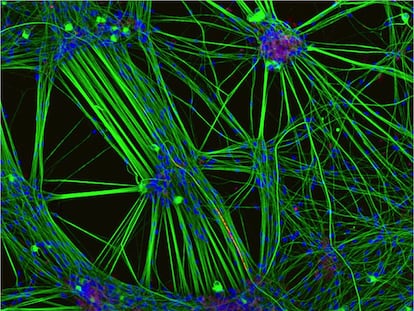Researchers discover more virulent and contagious variant of HIV
The finding, made by an international team of scientists, is evidence that viruses can evolve to become more – not less – aggressive

An urban legend, which became popular during the Covid pandemic, stated that viruses are destined to lose their malignancy as time passes. This is not true. An international team of scientists announced on Thursday the discovery of a more virulent and contagious variant of HIV, the virus that can cause AIDS if it is not treated. Researchers have so far detected 109 cases, practically all of them in the Netherlands and the majority (82%) among men who have sex with men. The variant, dubbed VB, triples or even quintuples the usual amount of virus in the bloodstream.
HIV jumped from chimpanzees to humans in around 1920, in what is now the Democratic Republic of the Congo, although it was not identified until 1983. Since then, some data from Europe and North America have suggested that the virus has become more virulent in some regions. The new variant, VB, is particularly aggressive.
HIV destroys CD4 cells, also known as T cells, which are a kind of white blood cell that protects people against infections. The World Health Organization (WHO) considers a level below 350 CD4 cells per cubic millimeter of blood to be “advanced” HIV. In the absence of treatment, men with the VB variant will reach this dangerous level around nine months after they are diagnosed, compared to the average of 36 months with the regular variant.
Epidemiologist Chris Wymant, from Oxford University in England, points out that HIV can affect different people in very different ways. In some individuals, the virus can cause AIDS in just a few months. For others, it can take decades. The amount of virus in the bloodstream can be thousands of times greater in some people. Convinced that these differences can be explained in part by the mutations of the virus, the Oxford team launched a project in 2014 to find genetic changes in HIV associated with a greater impact of the disease. The latest results were published on Thursday in Science magazine.
Wymant explains that human beings and the virus have entered an “arms race.” Currently, people with HIV can live normal lives thanks to a simple daily antiretroviral pill, which makes the virus undetectable and intransmissible. But HIV is still mutating. “The most unfavorable scenario would be the appearance of a variant that combines greater virulence, greater transmissibility and resistance to treatment,” the epidemiologist from Oxford warns. “The variant that we have discovered only has the first two properties.”
The HIV and SARS-CoV-2 pandemics show that viruses can evolve via natural selection toward greater virulence, and they will do thisBioinformatic professor Joel Wertheim
VB has more than 500 mutations, which is nearly 6% of the virus’s genome. This makes it hard to determine which are the changes responsible for its greater virulence. One of the possibilities considered by the scientific community is that the antiretroviral therapy itself favors the appearance of new versions of more aggressive HIV, but Wymant rules that out. His team calculates that the variant appeared in Amsterdam in the 1990s, just before the arrival of the most-efficient treatments. The Netherlands is one of the countries with the greatest availability of antiretroviral therapy, which will have avoided a larger spread of this variant or indeed any other. “Viruses cannot mutate if they can’t multiply,” the authors explain.
Wymant has a reassuring message. “People do not have to worry,” he says. “Finding this variant stresses the importance of the recommendations that were already in place: that people who are at risk of contracting HIV have access to periodic tests that allow for early diagnosis and immediate treatment.” The risk of contracting HIV is 35 times greater among people who inject drugs, 34 times greater for trans women, 26 times greater for sex workers of both sexes, and 25 times greater for men who have sex with other men, according to statistics from the Joint United Nations Programme on HIV/AIDS (UNAIDS).
The Covid-19 pandemic has demonstrated that a new variant of a respiratory virus can spread around the world in just a few weeks, but HIV travels on a scale of years. The results from Wymant’s team suggest that the VB variant appeared in the 1990s in Amsterdam and spread through the Netherlands in the 2000s, faster than other subtypes. Despite its greater transmissibility, the variant began to decline from 2010 onward, according to the Oxford University epidemiologist. “It’s very likely that this fall is the consequence of the major efforts in the Netherlands to reduce the transmission of any kind of HIV, via the growth of diagnostic tests and treatments,” Wymant explains.
The project at Oxford has analyzed the genetic sequencing of the virus in around 7,500 people who live with HIV in eight European countries – Germany, Belgium, Finland, France, the Netherlands, United Kingdom, Switzerland and Sweden – and Uganda. As well as 107 Dutch cases, researchers have found two more in Switzerland and Belgium.
Before this project, which is named BEEHIVE, the usual approach was to only examine fragments of the genetic sequencing of HIV, focusing on those where mutations associated with a greater resistance to medication usually appear. The Oxford team, which is led by epidemiologist Christophe Fraser, explains that years have been spent developing the IT tools necessary to carry out this research.
Bioinformatic professor Joel Wertheim, from the UC San Diego University in California, believes that the discovery of a more virulent variant of HIV is an important lesson for the Covid-19 pandemic. “While it is certainly possible that SARS-CoV-2 is evolving toward a more benign infection, like other coronaviruses that are responsible for the common cold, this final result is by no means predetermined,” explains Wertheim in a comment that was also published in Science magazine. The delta variant of the coronavirus, which was detected in India at the end of 2020, was more transmissible and virulent than prior versions, and was dominant across the planet until the end of 2021. “The HIV and SARS-CoV-2 pandemics show that viruses can evolve via natural selection toward greater virulence, and they will do this,” warns Wertheim.
Tu suscripción se está usando en otro dispositivo
¿Quieres añadir otro usuario a tu suscripción?
Si continúas leyendo en este dispositivo, no se podrá leer en el otro.
FlechaTu suscripción se está usando en otro dispositivo y solo puedes acceder a EL PAÍS desde un dispositivo a la vez.
Si quieres compartir tu cuenta, cambia tu suscripción a la modalidad Premium, así podrás añadir otro usuario. Cada uno accederá con su propia cuenta de email, lo que os permitirá personalizar vuestra experiencia en EL PAÍS.
¿Tienes una suscripción de empresa? Accede aquí para contratar más cuentas.
En el caso de no saber quién está usando tu cuenta, te recomendamos cambiar tu contraseña aquí.
Si decides continuar compartiendo tu cuenta, este mensaje se mostrará en tu dispositivo y en el de la otra persona que está usando tu cuenta de forma indefinida, afectando a tu experiencia de lectura. Puedes consultar aquí los términos y condiciones de la suscripción digital.
More information
Últimas noticias
Chris Martin, Taylor Swift, Elijah Wood and other famous wedding ‘crashers’
‘How does it feel to be a failure?’: Elizabeth Berkley’s journey from ‘Showgirls’ ridicule to vindication
The story of the Málaga virus: The code that haunted Google’s cybersecurity center director for 30 years
The impact of Ecuador’s mega-prison: A polluted river, cleared forests and military checkpoints
Most viewed
- Christian Louboutin: ‘Young people don’t want to be like their parents. And if their parents wear sneakers, they’re going to look for something else’
- The low-cost creative revolution: How technology is making art accessible to everyone
- All the effects of gentrification in one corner of Mexico’s Colonia Roma
- Liset Menéndez de la Prida, neuroscientist: ‘It’s not normal to constantly seek pleasure; it’s important to be bored, to be calm’
- December Social Security and SSI payments: Dates, double checks and the 2026 COLA increase











































